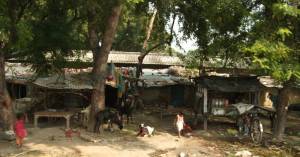Hot potatoes from Farmer Obama
The government of the USA has planned for India to become an important consumer of US agricultural exports and of US crop science. India is also planned as a host country for an agricultural research agenda directed by American crop-seed-biotech corporations. This is to be achieved through a variety of programmes in India, some of which began their preparation two years ago.
This agenda, labelled US-India cooperation by India’s current UPA-2 government and by the USA’s current Barack Obama administration, has the support of the American farm sector as its aim, not the support of India’s farmers and cultivators. The clear and blunt objective is to increase US agricultural exports and to widen as quickly as possible the trade surplus of the US agricultural sector.
This agenda has become clear following the three business and industry meetings held during the visit of US President Barack Obama — the ‘US-India Business and Entrepreneurship Summit’ in Mumbai on November 6, the ‘India-US: An Agenda for Co-Creation’ with the Confederation of Indian Industry (CII) in New Delhi on November 8, and the ‘US-India Conclave: Partnership for Innovation, Imperative for Growth and Employment in both Economies’ with the Federation of Indian Chambers of Commerce and Industry (FICCI) in New Delhi on November 9.
The US agri-business view has been projected in India by the US-India Business Council, a business advocacy group representing American companies investing in India together with Indian companies, with the shared aim of deepening trade and strengthening commercial ties.
In a document titled ‘Partners in Prosperity, Business Leading the Way, Advancing the US-India commercial agenda as the foundation for strategic partnership’ (November 2010) the business council stated: “India requires an ‘Ever-Green Revolution’ — a new programme which would engage the country’s rural sector, providing water utilisation and crop management ‘best practices’ to promote greater food security — this time based on technology to increase efficiency and productivity. The effort to vitalise India’s agriculture sector should be driven by business, and the first step is improving India’s farm-to-market global supply chain.”
This business-driven trade in agricultural goods and services was given formal shape two months ago during the inaugural meeting of what is called the India-US Agriculture Dialogue, on September 13-14, 2010 in New Delhi. India’s Foreign Secretary Nirupama Rao and USA’s Under Secretary (Energy, Economic and Agricultural Affairs) in the US State Department, Robert Hormats, co-chaired the ‘Dialogue’. Under this agreement India and the USA have set up three working groups for: ‘strategic cooperation in agriculture and food security’, ‘food processing, agriculture extension, farm-to-market linkages’, and ‘weather and crop forecasting’.
The ‘Agriculture Dialogue’ is designed to be the implementing process for the India-US Memorandum of Understanding for Cooperation in Agriculture and Food Security, signed almost a year ago by Obama and Singh. On November 24, 2009 they had agreed on a Memorandum of Understanding on Agricultural Cooperation and Food Security that will, according to the US State department, “set a pathway to robust cooperation between the governments in crop forecasting, management and market information; regional and global food security; science, technology, and education; nutrition; and expanding private sector investment in agriculture”.
‘Agriculture Dialogue’ is the new name given to a US-India plan for trade and investment in agriculture which saw its genesis on July 18, 2005, when Singh and then US President George W Bush announced the ‘US–India Knowledge Initiative on Agricultural Education, Teaching, Research, Service, and Commercial Linkages (AKI)’. At the time, apart from officials from government on both sides representing agriculture and crop bureaucracies, Indian and American universities and the private sector were on the AKI board.
The Indian agri universities were the Govind Ballabh Pant University of Agriculture and Technology (Pantnagar, Uttaranchal), the Tamil Nadu Agricultural University (Coimbatore, Tamil Nadu) and the Indian Veterinary Research Institute (Bareilly, Uttar Pradesh). India’s private sector was represented by Venkateshwara Hatcheries Ltd, Masani Farms (its owner was a National Horticultural Board director), ITC Ltd’s Agribusiness chief executive and Wal-Mart India. The American private sector was represented by Archer Daniels Midland Company and Monsanto.
Infochange India, which provides news and analysis on development news and social justice in India, has carried the rest of my article on the Obama visit to India here.
Share this:
Related
Written by makanaka
November 12, 2010 at 00:00
Posted in Uncategorized
Tagged with agri business, agricultural export, agricultural research, agriculture extension, Archer Daniels Midland, Barack Obama, biotech, CII, Confederation of Indian Industry, crop, crop science, Evergreen Revolution, farm sector, Federation of Indian Chambers of Commerce and Industry, FICCI, food processing, food security, Govind Ballabh Pant University, India-US Agriculture Dialogue, Indian Veterinary Research Institute, ITC Ltd, Manmohan Singh, Monsanto, nutrition, seed, State Department, Tamil Nadu Agricultural University, UPA government, US-India Business and Entrepreneurship, US-India Business Council, USA, US–India Knowledge Initiative, Wal-Mart



Leave a comment